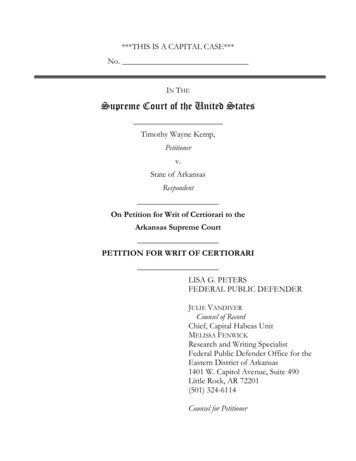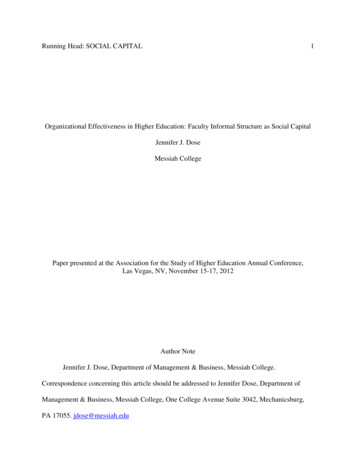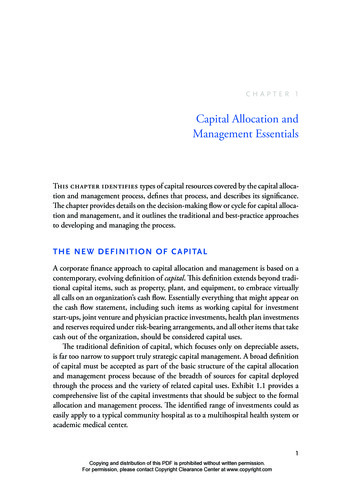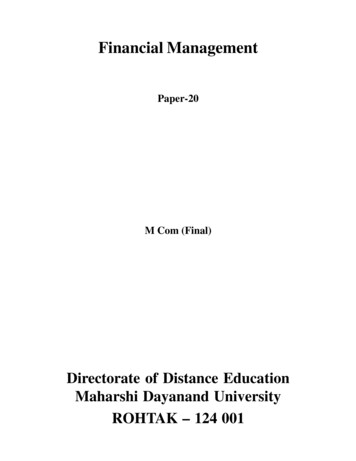
Transcription
***THIS IS A CAPITAL CASE***No.IN THESupreme Court of the United StatesTimothy Wayne Kemp,Petitionerv.State of ArkansasRespondentOn Petition for Writ of Certiorari to theArkansas Supreme CourtPETITION FOR WRIT OF CERTIORARILISA G. PETERSFEDERAL PUBLIC DEFENDERJULIE VANDIVERCounsel of RecordChief, Capital Habeas UnitMELISSA FENWICKResearch and Writing SpecialistFederal Public Defender Office for theEastern District of Arkansas1401 W. Capitol Avenue, Suite 490Little Rock, AR 72201(501) 324-6114Counsel for Petitioner
***THIS IS A CAPITAL CASE***QUESTION PRESENTEDWhether the October 7, 2021 decision of the Arkansas Supreme Court, finding thatTimothy Kemp was not prejudiced under Brady v. Maryland, was in conflict with thisCourt’s decision in Cone v. Bell where, in the words of the Arkansas court, “there is noprejudice under Brady and no reasonable probability that the outcome of the trialwould have been different had defense counsel been provided with the evidence,” butwhere that court did not distinguish between materiality of evidence with respect toguilt and materiality of evidence with respect to punishment, an omission which thisCourt has deemed “significant”?i
PARTIESThe caption contains the names of all parties.ii
DIRECTLY RELATED CASES State v. Kemp, No. CR 1993-2903 (Pulaski Cty.) (Dec. 5, 1994) (trial). Kemp v. State, No. CR 95-549 (Ark.) (Apr. 22, 1996) (direct appeal). State v. Kemp, No. CR 1993-2903 (Pulaski Cty.) (Nov. 5, 1997) (re-sentencing). Kemp v. State, No. CR 98-463 (Ark.) (Nov. 19, 1998) (direct appeal). Kemp v. State, No. CR 1993-2903 (Pulaski Cty.) (Oct. 23, 1999) (statepostconviction). Kemp v. State, No. CR 00-482 (Ark.) (Nov. 29, 2001) (rev’d more specificfindings). Kemp v. State, No. CR 1993-2903 (Pulaski Cty.) (Jan. 23, 2002) (statepostconviction). Kemp v. State, No. 00-482 (Ark.) (May 16, 2002) (state postconviction). Kemp v. State, No. CR 1993-2903 (Pulaski Cty.) (Sept. 30, 2008) (statepostconviction). Kemp v. State, No. CR 09-77 (Ark.) (Dec. 17, 2009) (state postconviction). Kemp v. State, No. CR 00-482 (Ark.) (Apr. 1, 2010) (denying motion to recall themandate). Kemp v. State, No. CR 95-549 (Ark.) (Sept. 30, 2010) (denying coram nobis). Kemp v. Kelley, No. 5:03-cv-55 (E.D. Ark.) (Oct. 6, 2015) (habeas). Kemp v. Kelley, No. 15-3849 (8th Cir.) (May 16, 2019) (habeas appeal). Kemp v. Payne, No. 19-7476 (U.S.) (May 18, 2020) (denying certiorari). Kemp v. Arkansas, No. CR-95-549 & CR-98-463 (Ark.) (Oct. 7, 2021) (denyingapplication to proceed on writ of error coram nobis).iii
TABLE OF CONTENTSQuestion Presented . iParties . iiDirectly Related Cases. iiiTable of Contents . ivTable of Authorities . vPetition for a Writ of Certiorari . 1OPINIONS BELOW . 1JURISDICTION. 1CONSTITUTIONAL AND STATUTORY PROVISIONS INVOLVED. 1INTRODUCTION . 1STATEMENT OF THE CASE . 2REASONS FOR GRANTING THE PETITION . 7I. The decision of the Arkansas Supreme Court presents a conflict with thiscourt’s decision in Cone v. Bell. 8Kemp v. Arkansas, No. CR-95-549 . Appendix AKemp v. Arkansas, No. CR-98-463 .Appendix Biv
TABLE OF AUTHORITIESCases:Abdul-Kabir v. Quarterman, 550 U.S. 233 (2007) . 13, 17Andrus v. Texas, 140 S. Ct. 1875 (2020) . 18Brady v. Maryland, 373 U.S. 83 (1963) . 8Buckley v. State, 2007 WL 1509323 (Ark. 2007) . 9Cone v. Bell, 556 U.S. 449 (2009) . passimEchols v. State, 125 S.W.3d 153 (2003) . 9Eddings v. Oklahoma, 455 U.S. 104 (1982). 16Howard v. State, 403 S.W.3d 38 (Ark. 2012) . 9, 10Kemp v. State, 60 S.W.3d 404 (Ark. 2001) . 14Lockett v. Ohio, 437 U.S. 586 (1978) . 16Sears v. Upton, 561 U.S. 945 (2010). 16Tison v. Arizona, 481 U.S. 137 (1987) . 14Wallace v. Arkansas, 545 S.W.3d 767 (Ark. 2018) . 10Wiggins v. State, 539 U.S. 510 (2003) . 16Other Authorities:J. Thomas Sullivan, Brady-Based Prosecutorial Misconduct Claims, Buckley, and theArkansas Coram Nobis Remedy, 64 Ark. L. Rev. 561, 617 (2011). 9Michael A. Simons, Born Again on Death Row: Retribution, Remorse, and Religion, 43 Cath.Law 311, 322 (2004). 19Scott E. Sundby, The Capital Jury and Absolution: The Intersection of Trial Strategy, Remorse,and the Death Penalty, 83 Cornell L. Rev. 1157, 1558 (Sept. 1998). 19v
Theodore Eisenberg, Stephen P. Garvey, & Martin T. Wells, But was he sorry? The Roleof Remorse in Capital Sentencing, 83 Cornell L. Rev. 1599, 1633 (Sept. 1998) . 19vi
PETITION FOR A WRIT OF CERTIORARITimothy Wayne Kemp respectfully petitions for a writ of certiorari to reviewthe judgment of the Arkansas Supreme Court.OPINIONS BELOWThere are two opinions released on the same day at issue. The first opinion ofthe Arkansas Supreme Court is reported at 629 S.W.3d 804 (Ark. 2021). (App. A). Thesecond related opinion is reported at 2021 Ark. 172. (App. B).JURISDICTIONThe judgment of the Arkansas Supreme Court entered its opinions on October7, 2021. This Court has jurisdiction under 28 U.S.C. § 1257(a).CONSTITUTIONAL AND STATUTORY PROVISIONS INVOLVEDU.S. Const. amend XIV:. . . nor shall any state deprive any person of life, liberty, or property, without dueprocess of law.INTRODUCTIONTimothy Kemp shot four people in a rural Arkansas trailer in 1993. From themoment of his arrest, he told the police that “these people beat his ass and threatenedhim and he was just defending himself.” R 1480; RS 984. At his trial, the prosecutionvigorously disputed Kemp’s claims of self-defense. A key witness who was at thetrailer that night testified repeatedly that she did not see any of the victims with a gun.Decades later, notes from the prosecutor’s file revealed that the witness lied on thestand and that she not only saw one victim with a gun, but he told her he planned to1
use the gun to scare Kemp. Using the only state court avenue to vindicate a Brady v.Maryland claim discovered after trial, Kemp filed an application to reinvest the circuitcourt with jurisdiction to hear a writ of error coram nobis. The Arkansas Supreme Courtheld there was no reasonable probability of a different outcome and declined toreinvest jurisdiction. In doing so, the court failed to distinguish between themateriality of the suppressed evidence with respect to guilt and punishment, givingrise to the instant Petition.STATEMENT OF THE CASETimothy Kemp and his girlfriend, Becky Mahoney, arrived on October 4, 1993, asvisitors to Wayne Helton’s trailer. After a day of steady drinking, Kemp and Mahoneyjoined Helton, Robert Phegley and Cheryl Phegley (father and daughter), in moredrinking. At some point in the evening, Richard Falls joined the group. As the nightwore on, Kemp wanted to leave but Mahoney did not. The group told Kemp to leavewithout Mahoney.Shortly after his arrest, Kemp told the police that he did leave, but only briefly, andthat he returned to see if Mahoney had changed her mind and wanted to leave too.According to Kemp, on his return he was greeted outside with taunts, physicalviolence, and threatened with a gun. Kemp grabbed his own gun out of his truck,grappled with Helton at the front door, and ended up shooting Helton, RobertPhegley, Cheryl Phegley, and Falls. Mahoney hid in the closet and was physically2
unharmed. The police found a pistol between the bodies of Helton and RichardPhegley.Kemp was charged with four counts of capital murder and the State sought thedeath penalty. The prosecution’s theory of the case differed significantly fromKemp’s. The State argued that Kemp left the trailer, drove home, retrieved his gun,parked a distance away from the trailer, skulked toward the front door where, afterknocking, he unloaded his gun on the unsuspecting occupants.To support the self-defense theory, the defense attorney questioned Mahoneyabout whether she saw a gun at the trailer that night. She flatly denied seeing a gun.Q: And you say that Tim went out by himself?A: Tim left by himself.Q: Did you see a gun at that time?A: No, sir.Q: Did you ever see a gun?A: No, sir.Q: You didn’t see a pistol at any time?A: I don’t remember.Q: You don’t remember. You don’t recall if someone pulled a pistol on him?A: No, sir.Q: Okay. You just didn’t see one?A: Nobody pulled a pistol on him.Q: Okay. You didn’t see a pistol at all. Is that right? Is that what you’re saying?A: Yes, sir.R 1415. Though there was a gun found near Helton’s body, the jury heard noevidence that Helton intended to scare Kemp with the weapon. Kemp’s self-defensearguments were unavailing in the guilt phase and the jury found Kemp guilty of fourcounts of capital murder.3
At the penalty phase, the defense kept its focus on Kemp’s claims of self-defensebut tailored their presentation to the jury’s task at penalty. The defense argued thestatutory mitigating factor that “the capital murder was committed . . . under extrememental or emotional distress” was established because “[h]e had been threatened.” R1950. The defense also argued that the statutory mitigating factor related to “unusualpressures or influences” was present because “[t]here was a gun. A gun found. . . Itwas at the foot of one of the people. . . He had been told that he was going to beat hisass. He was fearful. He was upset.” R 1950. The defense also presented a mitigatingcircumstance that Kemp “believed he was acting in self-defense.” R 1966.The defense argued that these threats were particularly potent because of Kemp’spsychological impairments. R 1950–51. Under this theory, and particularly relevant tothe question presented, even if the provocation was insufficient to mount a guiltphase defense, it still mitigated the crime. A defense psychologist testified that Kempwas “less able to control his impulses,” “more likely to feel threatened by just aboutanything” but would respond to a significant threat “all the more strongly.” R 1905–06. The psychologist based his opinion in part on “claims of threats from the otherparties at the house that evening.” R 1918. The prosecution criticized the psychologistfor taking Kemp’s word that he had any reason to be fearful. Id.In her penalty phase closing, the prosecutor disputed each mitigatingcircumstance and argued there was “no evidence, no evidence, no evidence that he4
was acting in self-defense.” R 1944. Returning four death sentences, the jury onlyunanimously found two mitigating circumstances, both related to Kemp’s upbringing.On direct appeal, three of Kemp’s death sentences were overturned due to animproper aggravating circumstance. The State sought to reimpose those deathsentences. The parties largely repeated their presentations and Mahoney again lied:Q: Okay. Did you see a gun? Did you see any of them with a gun?A: No, sir.Q: Okay. If there was a gun there, you wouldn’t be surprised to see it in thepictures though, would you?A: I didn’t — — I never did see no gun.Q: You never saw a gun?A: No, sir.Q: But you’re not denying that someone had a gun there. Is that right?A: I never seen no gun.RS 914-15. The defense psychologist tempered his testimony about Kemp’sperception of threats—explaining that Kemp may have “misperceived” a danger. RS1056.Using Kemp’s longer statement to police, the defense again urged Kemp’s belief inself-defense as a mitigating factor. The prosecution argued that the statement was “apack of lies . . . all about he’d been beaten and threatened and they followed him outinto the yard and they pulled their gun on him.” RS 1167. Moreover, the prosecutortold the jury these lies showed that Kemp had “[n]o remorse. No feeling about thelives he’s taken.” Id. The defense conceded that Kemp “does not have a defense underour law to shooting those people” but argued that the jury’s moral decision should beinfluenced by the circumstances of the offense—including whether Kemp committed5
the crime under an emotional disturbance, unusual pressures, or a belief in selfdefense. RS 1178–83. The prosecution responded she would not spend any time onthe question of whether Kemp believed he was acting in self-defense because“[t]here’s no evidence of that whatsoever,” and Kemp’s claims that he was threatenedwere “crazy lies.” RS 1190. The jury found the presence of the single aggravatingfactor—that Kemp created a great risk of death to another person. The jury did notunanimously find any mitigating circumstances.During discovery in federal habeas, Kemp received never-before disclosed parts ofthe prosecutor’s file: a work-product file and a victim-assistance file. The workproduct file contained notes taken by the prosecutor in her own witness interviews.There, Mahoney related that “Wayne showed Becky a pistol that he had said hewould use it to scare Tim.” There is no dispute that these files had never previouslybeen disclosed to Kemp.Kemp raised a Brady claim based on this and other revelations in the prosecutor’sfile in habeas proceedings. The federal district court found the Brady claim to beinexcusably procedurally defaulted and declined to certify it for appeal. The EighthCircuit Court of Appeals likewise did not certify the issue for appeal. Kemp includedthe procedural question in his petition to this court that otherwise dealt with anadjudicated Strickland issue. Certiorari was denied. Kemp v. Payne, No. 19-7476 (U.S.)(May 18, 2020).6
Following denial of certiorari, and in line with Arkansas Supreme Court precedent,Kemp applied to the Arkansas Supreme Court to reinvest the trial court withjurisdiction to hear his Brady claims. After full briefing and oral argument, theArkansas Supreme Court released two opinions regarding the case (one detailedopinion under the trial case number and another adopting that rationale in theresentencing case number). See Appendix A and B. While the State urged alternativegrounds for denial, the court denied Kemp’s application squarely on the merits of hisBrady claim.REASONS FOR GRANTING THE PETITIONAt the application stage of coram nobis review, the Arkansas Supreme Courtdetermined whether Kemp’s Brady claim was potentially meritorious. To do this, thecourt considered the reasonableness of the allegations and the probability of theirtruth. A finding of actual prejudice or reasonable probability of a different outcomewas not required. The court’s decision, declining to reinvest jurisdiction, has barredconsideration of the merits of Kemp’s Brady claim, but this Court’s precedent dictatesthat further review is warranted.Though procedurally distinguishable, the instant case is factually analogous to thisCourt’s decision in Cone v. Bell, 556 U.S. 449 (2009). By “[s]ummarily discounting” thecontention that Kemp’s Brady claim was potentially meritorious and material to hisdeath sentence, the Arkansas Supreme Court’s decision conflicts with this Court’sholding in Cone. Id. at 464. Failing to distinguish between the materiality of suppressed7
evidence at both guilt and sentencing is “an omission [this Court] find[s] significant.”Id. at 476. “Because the evidence suppressed at [Kemp’s] trial may well have beenmaterial to the jury’s assessment of the proper punishment in this case, a full reviewof the suppressed evidence and its effects is warranted.” Id. at 475.I.The decision of the Arkansas Supreme Court presents a conflict withthis court’s decision in Cone v. Bell.In Cone v. Bell, this Court emphasized a constitutional mandate that prejudice fromsuppressed Brady evidence must be examined for both the guilt and penalty phases ofa capital murder trial. Id. at 469; citing to Brady v. Maryland, 373 U.S. 83, 87 (1963)(suppression violates due process when the evidence is material to guilt or punishment)(emphasis added). Reasoning that evidence, while not exculpating, may play amitigating role in the jury’s sentencing recommendation, and because no court priorhad “fully considered whether the suppressed evidence” may have swayed the jury atsentencing, this Court remanded for a “full review” of Cone’s Brady claim. Id. at 475.This case is plainly controlled by and analogous to Cone. Here, as in Cone, theprosecution suppressed a witness statement that would have corroborated Kemp’sclaims of self-defense and supported multiple mitigating factors at the penalty phase.Here, as in Cone, the prosecution not only presented Kemp as a remorseless killer,they discredited his defense by calling it “a pack of lies” and emphasized there wasabsolutely no evidence Kemp was threatened, while simultaneously sitting on the veryevidence they claimed was missing. Here, as in Cone, the lower court only “passed8
briefly on the merits” of Kemp’s Brady claim and failed to distinguish between themateriality of the suppressed statement as to guilt and punishment. Id. at 452. Here, asin Cone, a full review of the penalty-phase prejudice is absent and warranted. ThisCourt emphatically recognized in Cone that a Brady claim which fails with respect toguilt may still have merit as to sentencing. Failing to distinguish between the two is aconstitutionally deficient analysis.A. The Arkansas Supreme Court opinion rested solely on whether Kempcould establish Brady prejudice.The writ of error coram nobis is the only practical vehicle by which a petitioner maypresent a Brady claim discovered after trial in Arkansas state courts. See Buckley v. State,2007 WL 1509323 at *2 (Ark. 2007) (“[a] petitioner may seek relief for prosecutorialmisconduct at trial, in a motion for new trial, or through error coram nobisproceedings”); J. Thomas Sullivan, Brady-Based Prosecutorial Misconduct Claims, Buckley,and the Arkansas Coram Nobis Remedy, 64 Ark. L. Rev. 561, 617 (2011) (“Brady-basedmisconduct violations must be litigated through the writ of error coram nobis process”).If a case has been affirmed on direct appeal, before a trial court may consider a writ oferror coram nobis, the Arkansas Supreme Court must grant permission and reinvest thecircuit court with jurisdiction. Echols v. State, 125 S.W.3d 153 (2003). That court will doso “when it appears the proposed attack on the judgment is meritorious.” Howard v.State, 403 S.W.3d 38, 43 (Ark. 2012) (citing Flanagan v. State, 2010 Ark. 140, at *1 (Ark.2010)).9
The writ exists to address four categories of error—one of which is materialevidence withheld by the prosecutor. Id. This category of error also covers witnesstestimony that “materially conflicts” with a statement “withheld or suppressed by thestate.” Wallace v. Arkansas, 545 S.W.3d 767, 770–71 (Ark. 2018). The ArkansasSupreme Court dubs this category of error a “Brady violation” and applies Brady andthis Court’s related precedents in adjudicating such claims. Howard, 403 S.W.3d at 44.Thus, the coram nobis “materiality” standard is equivalent to Brady’s: prejudice isestablished when there is a “reasonable probability” that the outcome of the trialwould be different but for the state suppression of favorable evidence. Id. at 46.At the application stage, Kemp needed only convince the Arkansas Supreme Courtthat his claims had “apparent merit.” Id. at 47. The Arkansas Supreme Court assumedthat Kemp had established the first Brady element—that the evidence was suppressed.Thus, the sole question before the Court was whether the “circuit court could find thatthere is a reasonable probability that, had the evidence been disclosed, the result ofthe proceeding would have been different.” Id. at 45 (emphasis added). The ultimatemerits of the claim—whether there was a “reasonable probability” of a differentoutcome—is left to the circuit court on reinvestment. Id. at 46 (“The reasonableprobability standard applies to the circuit court’s evaluation of the merits of theerror coram nobis petition and not to this court’s decision to grant or deny permissionto proceed with filing the petition in circuit court.”). Because the Arkansas SupremeCourt reinvests jurisdiction whenever a Brady claim has “apparent merit,” and because10
on this record Kemp’s claim does have merit, the court’s “summary treatment” andrejection of Kemp’s Brady claim warrants further review. Cone, 556 U.S. at 474.B. The Arkansas Supreme Court violated Cone v. Bell and Brady v.Maryland by not distinguishing between the materiality of evidencewith respect to guilt and the materiality of evidence with respect topunishment.The Arkansas Supreme Court rejected Kemp’s claims in two related opinions. Thefirst opinion deals with Kemp’s initial trial and sentencing—for which he has fourcapital murder convictions and one death sentence. Appendix A. The second opiniondeals with Kemp’s resentencing where he was resentenced to three death sentences.Appendix B. The Arkansas Supreme Court departed from this Court’s precedentwhen it failed to separately analyze prejudice as to guilt or penalty. The court’s firstopinion fails to address the impact of the suppressed evidence on Kemp’s mitigationcase and simply concluded the new information could not have changed the outcomeof Kemp’s trial. Appendix A at 8. The court’s opinion as to Kemp’s resentencinglikewise made no effort to distinguish between the impact of the suppressed evidenceat the trial and original sentencing and Kemp’s resentencing. Appendix B.The Arkansas Supreme Court’s equivocal treatment of the prejudicial impact ofthe suppressed evidence departs from this Court’s precedent in Cone v. Bell. GaryCone was sentenced to death for the murder of two people he claimed he committedwhile suffering from acute psychosis caused by drug addiction. Cone, 556 U.S. at 451.At trial, the defense’s theory was that Cone’s drug-induced psychosis rendered him11
legally insane, or at least reduced his moral culpability for sentencing purposes. Id. at454–55. The state discredited this theory by arguing there was no evidence that Conewas drug-addicted, and thus no evidence his actions were the result of drug-relatedpsychosis. Id. The prosecutor described Cone’s actions as “premeditated, cool,deliberate,” and summarized his claims of drug addiction as “baloney.” Id. at 455-56.During postconviction proceedings, Cone was granted access to the prosecutor’sfile where he discovered numerous undisclosed witness statements corroborating hisdrug use. Armed with this new evidence, he argued the evidence was exculpatory toboth guilt and punishment. The lower courts rejected the claim finding that thewithheld statements would not have overcome the overwhelming evidence of Cone’sguilt and discounting Cone’s contention that the withheld evidence would haveimpacted his sentencing. The lower court reached the question of sentencingprejudice but summarily found evidence of Cone’s drug use “did not mitigate hisculpability sufficient to avoid the death sentence.” Id. at 464.It was under these circumstances that this Court granted certiorari and held thatno lower court had “fully considered whether the suppressed evidence might havepersuaded one or more jurors” to vote to imprison Cone for life rather than sentencehim to death. Id. at 475. Although the evidence was immaterial to the jury’s finding ofguilt, it “may well have been material to the jury’s assessment of the properpunishment in this case.” As such, “a full review of the suppressed evidence and itseffects” was warranted. Id.12
Like Cone, “the distinction between the materiality of the suppressed evidence withrespect to guilt and punishment is significant in this case.” Id. at 473. Kemp hasmaintained since his arrest that he was threatened, that his actions were notpremeditated, and that, even if his belief was unreasonable, he believed he was actingin self-defense thus mitigating the crime. Whereas the guilt phase of a capital trialrequires a jury to objectively weigh facts in evidence, the penalty phase involvessubjectively weighing mitigating and aggravating factors to arrive at a moral judgment.Abdul-Kabir v. Quarterman, 550 U.S. 233, 252 (2007) (holding that a jury must beallowed to give effect to mitigating evidence and to express “its ‘reasoned moralresponse’ to that evidence”) (quoting California v. Brown, 479 U.S. 538, 545 (1987)).Because the jury’s job is different at each stage—the prejudice analysis, too, must bedifferent.This Court clearly recognized this distinction in Cone, where it noted a “criticaldifference” between the high standard Cone was required to satisfy to establish hisinsanity defense and the “far lesser standard that a defendant must satisfy to qualifyevidence as mitigating in a penalty hearing in a capital case.” Cone, 556 U.S. at 474. Sotoo here. At guilt, the jury had to determine if facts were sufficient to support whetherKemp indeed acted in self-defense—either to establish an affirmative defense or tocreate a reasonable doubt as to whether the crimes were premeditated. But at penalty,the jury needed only to consider whether Kemp believed he was acting in self-defense.Even if Mahoney’s statement would not have carried the day in the guilt-phase, her13
suppressed statement supported Kemp’s belief and provided crucial mitigatingevidence of his mental state. As in Cone, there is a “critical difference” between whatKemp was required to present and prove to establish self-defense at the guilt phaseand the “possible mitigating effect” evidence of threats would have had at his penaltyphase. Id. at 474.i.Guilt phase and penalty phase prejudice require separate analysis.Whether Kemp was provoked or threatened before he shot his own gun wasessential to his defense at both stages. Indeed, his attorney stated that imperfect selfdefense was “the heart” of Kemp’s defense in the mitigation phase of trial. Kemp v.State, 60 S.W.3d 404, 407 (Ark. 2001). Evidence that Kemp was threatened orprovoked (or believed that he was) could have affected the jury’s assessment of hismoral culpability at sentencing. See e.g., Tison v. Arizona, 481 U.S. 137, 157 (1987)(“Many who intend to, and do, kill are not criminally liable at all—those who act inself-defense or with other justification or excuse. Other intentional homicides, thoughcriminal, are often felt undeserving of the death penalty––those that are the result ofprovocation.”).Specifically, there are two ways in which Mahoney’s suppressed statement weigheddifferently in the penalty phase. First, and most obviously, the suppressed evidencewould have supported Kemp’s related mitigating circumstances. Second, the absenceof the statement permitted the prosecution to push her theory that Kemp was a liar,he lacked remorse, and he was, as such, more deserving of the death penalty.14
The defense offered three mitigating circumstances which would have beensupported by the suppressed evidence: that the crime was committed while Kemp wasunder emotional distress; that the crime was committed while Kemp was underunusual pressures; and that Kemp believed he was acting in self-defense. To maketheir case during the penalty phase, the defense presented a psychologist who testifiedthat Kemp’s unique psychological profile made him more likely to overreact tothreats. R 1905–10, RS 1054–58. Mahoney’s statement would have supported thesemitigating circumstances by bolstering Kemp’s claim that he was threatened—or byestablishing that the dynamics between Kemp and the victims were heated and morethan simply a “fight with [his] girlfriend” as the prosecution contended R 1957.On cross-examination, the prosecutor discredited the defense expert by exploitingher suppression. Evidence that Kemp was threatened or fearful was relevant to thepsychologist’s assessment and to Kemp’s mitigation, but the prosecutor demean
sentences. The parties largely repeated their presentations and Mahoney again lied: Q: Okay. Did you see a gun? Did you see any of them with a gun? A: No, sir. Q: Okay. If there was a gun there, you wouldn't be surprised to see it in the pictures though, would you? A: I didn't — — I never did see no gun. Q: You never saw a gun? A: No, sir.











